Craig Barr-Green & Francis Martin


About Author
Craig Barr-Green writes picture books, non-fiction titles and theatre productions for children. He lectures in Children's Literature at Falmouth University and is a seasoned children's bookseller and storyteller. He set up Clickety Books to focus on early language development and is a passionate advocate for children's literacy and neurodivergent representation.
Francis Martin is an illustrator and artist living out in the wilds of Pendle Witch Country, conjuring up pictures for stories by splodging ink and charcoal all over the place. He is a graduate of Cambridge School of Art's MA in Children's Book Illustration. He loves dogs and travelling across the moors in trains.
Interview
Gina Kaminski Saves the Wolf (Little Tiger Press)
September 2023
Competition: Win a copy of Gina Kaminski Saves the Wolf
When the classroom is too busy, and too loud, for Gina Kaminski, she is taken to a quiet place to read Little Red Riding Hood. But Gina doesn't like the ending of the story and decides to enter fairy land find a way to save the Wolf. In so doing, she becomes the true hero of the story. While it is not overt in the text, Gina Kaminski is autistic. Children who are neurodivergent will find much to recognise in Gina's world, while the story will also help all children to better understand autism.
Review: 'This is the ideal book to empower every child to be the hero of their own story.'
Gina Kaminski Saves the Wolf is an energetic picture book that is full of heart - and emojis. We speak to author Craig Barr-Green and illustrator Francis Martin to find out more about how it was created:
"Cressida Cowell said that every child has the right to 'see themselves reflected in a book.'
Neurodivergent representation is so important, as is all representation. The quality of that representation is critical."
Q&A with Craig Barr-Green
1. Can you tell us about yourself, loves and hates, and why you write for children?
I write books and theatre scripts for children. I absolutely love picture books. The fantastical fusion of text and image and clever page design makes it such a remarkable medium. David McKee is my picturebook hero. Mr Benn 123456789 and Not Now, Bernard are his masterpieces, in my opinion. Shirley Hughes tells the most complex stories with a simple frame. I have so much respect for the magic of illustrators like Maurice Sendak, Nadia Shireen, Britta Teckentrup, Janet Ahlberg, Rebecca Cobb, Jan Pieńkowski, Dapo Adeola, Judith Kerr, Francis Martin (obvs.)… all are fantastic! I could talk about picture books all day. Which is lucky, because I also lecture Children's Literature. Which is as awesome as it sounds.
Writing for children is such an important job, and one I take seriously and enjoy immensely. Children's literature is an endless well of wonder. I recently read Katya Balen's October, October and it utterly blew me away. One of the finest novels I have read in years - for any age - but it is unmistakably and absolutely a children's book. It's such a golden age! We are so lucky to have Katherine Rundell, Jasbinder Bilan, Kiran Millwood Hargrave, Jason Reynolds, Onjali Q. Rauf, Frank Cottrell-Boyce and Jaqueline Wilson (the Queen!) all writing at the same time! Young Adult is a firework display of invention, passion and sincerity. Picture books are more kaleidoscopic than ever. If we can ensure all children can have access to these books, only good things will come.
As for hates: life is too short. There is so much to be angry about, so I think it's critical to say what you love and shine a spotlight there. Champion what is good. That said I absolute despise quiche. It makes me sick. Be gone with you quiche and your wobbly baked egg devilry!
"I chose Little Red Riding Hood because it is such a rich, iconic and profoundly odd story.
I also believe that the wolf got a bad deal."
2. What is your picture book Gina Kaminski Saves the Wolf about? Why did you decide to retell this fairy tale, with a new ending by Gina Kaminsky?
This is the story of a girl who listens to the story of Little Red Riding Hood, disagrees with the ending, so steps into the story to rectify matters. On a deeper level, this is the story of a girl who is struggling with the sensory overload of her classroom. Her brilliant one-to-one takes her to a quiet zone - a small library - and allows Gina to decompress before returning to the classroom.
There are two stories intertwining here. I chose Little Red Riding Hood because it is such a rich, iconic and profoundly odd story. I also believe that the wolf got a bad deal. I adore the Cartoon Saloon animation Wolfwalkers, which is such an inventive (stunningly hand-drawn), and sympathetic reappraisal of displaced wolves.
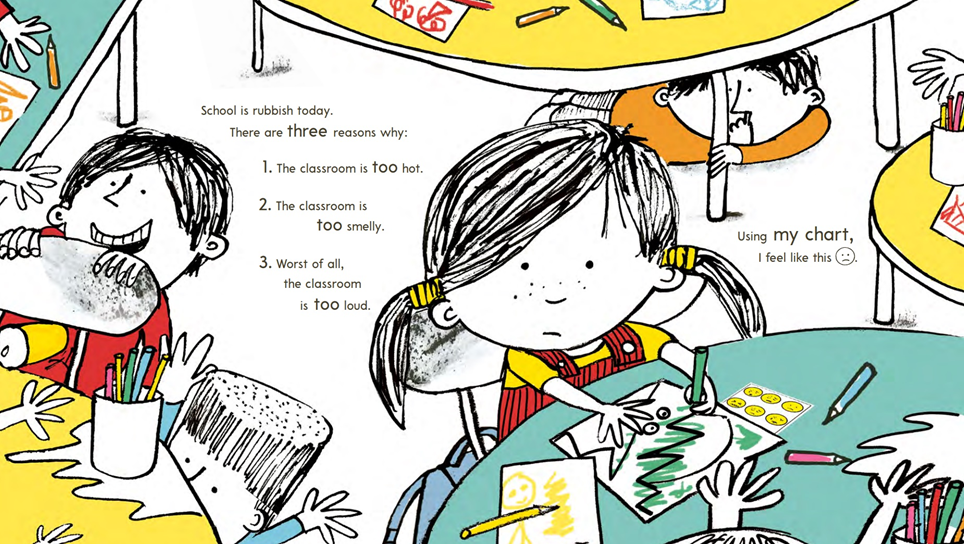
3. Gina Kaminski is a fabulous character; did anyone help inspire her?
She arrived fully formed, out of nowhere. Genuinely. She just started speaking, on the page, as soon I started typing. The book went through endless drafts, but her voice never changed. There is a lot of me in Gina but she is very much herself. I can imagine Gina in any situation and write down her thoughts in detail. Francis Martin has completely captured her spirit and personality with his beautiful illustrations.
"I read the story in a school as an early road test, and a boy ran off to show me his own mood chart.
It was a wonderful moment."
4. Gina has a particular style of narration, taking us step by step through her story, and using emojis through the story to explain how she is feeling. What would you like children to understand about her from this?
The step by step 'telling' of the original Little Red Riding Hood was a way to make sure every child was familiar with the core story - or at least a classical version of it: fairy tales and folk tales are slippery things with many variations. I don't want to assume anything as the readership is young and accessing stories for the first time. This technique also foreshadows the three big story beats that are about to follow in the 'retelling'. Hopefully these act as feed lines that make the punchlines funnier. For example: the eating of the cake, which is my favourite page!
The emojis are a simplified version of mood charts and communications aids that can be used in educational settings, or at home, with children who find it difficult to communicate, for whatever reason. I read the story in a school as an early road test, and a boy ran off to show me his own mood chart. It was a wonderful moment. Visual aids can be so useful for everyone when used well, like visual timetables, for example. I thought it would be cool to see Gina's journey symbolised and charted by emoji. It has been lovely watching teachers, TAs and one-to-ones point at the emoji and see something that is familiar in their day-to-day practice.
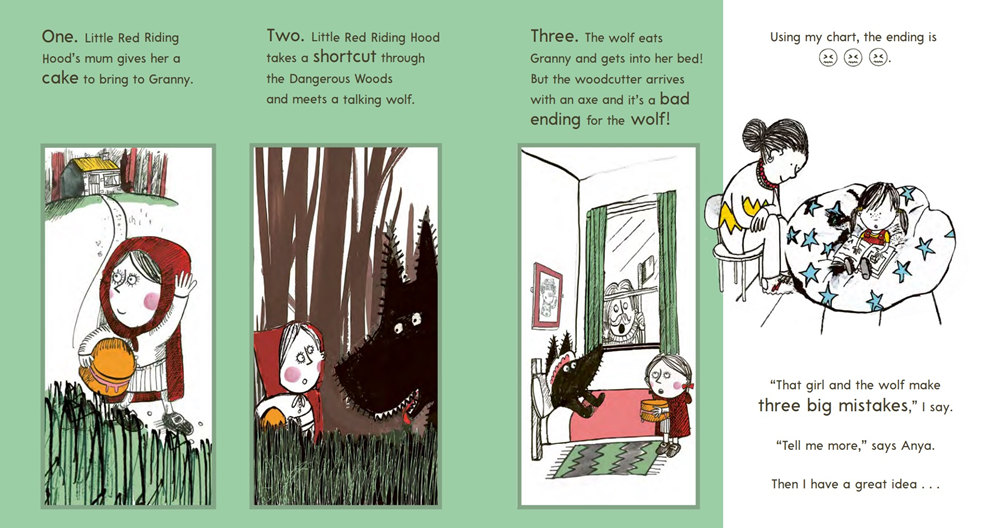
5. How would you like to see this story shared with children and perhaps taken further with them?
This is an adventure about a girl who steps into a fairy tale to fix its problems. It's funny and its exciting for all children (I hope). Gina is also autistic, although it is never spelled out explicitly within the text itself. I want people to cheer Gina for being Gina and for saving the day.
It was critical to show some of her behaviours, and how the environment can affect her. Some children will see themselves, others will see an engaging character having an adventure. As (the wonderful) Chris Riddell wrote, 'a good book is an empathy engine', and I do hope that this book will offer children an insight into my character's inner life.
Gina's one-to-one helper is such an important character to me. I wanted her to be front and centre and seen and championed. These wonderful people can empower children, guardians and educational practitioners. Anya is calm, dynamic and great at her job. Bravo, Anya!
6. What do you think about how illustrator Francis Martin has interpreted your text? Any favourite moments?
He has worked magic! It's always a wonderful moment - seeing illustrations for the first time - and I was just swept away by his vision. Gina has so much character. The book looks timeless and contemporary all at once. I adore the title card pages ('Mistake Number One' etc). The illustration and use of colour is exceptional. There is a little bit of Tove Jansson in there, and some Charles M Shulz, but the work is unmistakably Francis. He has so much energy and wit and his work exudes warmth, and depth of character. A personal highlight is Francis's interpretation of the Woodcutter. He is pompous and preposterous and absolutely note perfect. I am such a fan of Francis Martin. Check out his landscape art too! It's fantastic.
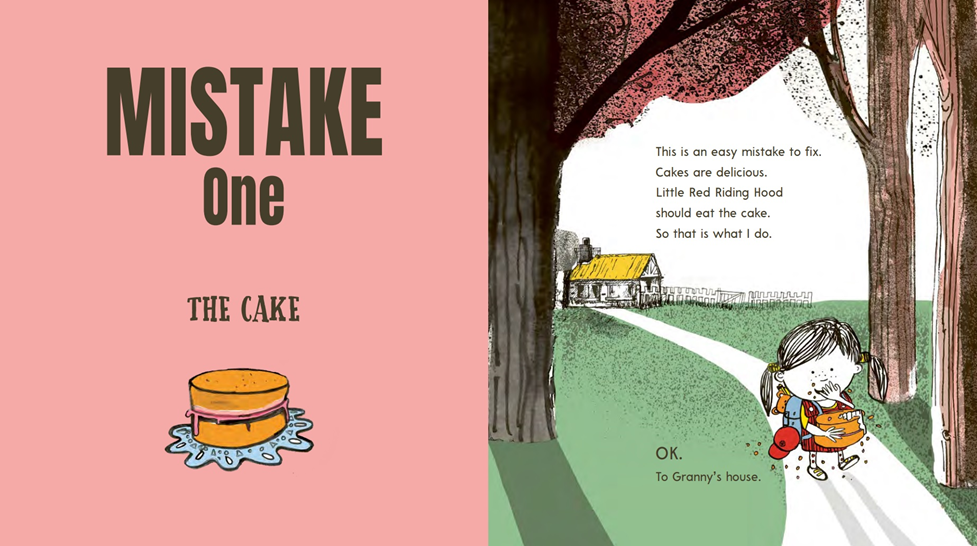
7. Do you want to see more picture books that feature neurodivergent children? Are you planning to write more about Gina or stories about other neurodivergent characters?
To quote another Children's Laureate, Cressida Cowell said that every child has the right to 'see themselves reflected in a book.' Neurodivergent representation is so important, as is all representation.
The quality of that representation is critical. I wanted Gina to have depth and agency and operate as a picturebook hero. I agree with Dr Rudine Sims Bishop's concept of 'mirrors, windows and sliding glass doors'. A good book can offer reflection, show new lives, and offer a chance to slide open the glass door and enter this new world to live vicariously. So much consideration went into Gina's representation while maintaining the verve of the storytelling.
I am indeed planning to write more Gina. In fact… watch this space. I have also finished a draft of a MG adventure with a ND POV. Again, watch this space!
8. What are your favourite ways of spending time away from your desk?
I need constant input! I love so many things. I love films, and the cinema is a happy place. My teenage children are massive fans of comedy, so It's a pleasure to watch things with them and laugh, or hit the cinema as a family with popcorn and Tango Ice Blasts. I love food and get giddily happy when presented with fresh seafood. Basically, I love anything that can be looked at, or listened to, or watched, or eaten. I drink it all in, happily.
I am very restless. I walk a lot because I cannot drive, so I tend to look at everything as I walk. I love architecture and I can swoon at buildings. My wife once had to pull me out of the road before I was hit by a car because I was suddenly mesmerised by a church in Whitechapel in London. She is a novelist and writes brilliant twisty thrillers and one of my life's joys is that I get to read everything she writes. We have long walks, brainstorming each other's work. For example, the spread in which Gina has to throw a breadstick to distract the wolf came from an idea in a brainstorming walk.
I read a lot about music and am currently researching a book about classic Power Ballads (the greatest songs ever written). Podcasts are a great way of filling my brain with comedy, which can be calming at night. The magnificent Three Bean Salad is my current favourite. If I can't fill my time, I get terribly fidgety and become a bit paralysed by indecision. I play darts with a lovely group of novelists, directors, actors and musicians in Cornwall. We can barely hit the board and struggle with the Maths but we are dead keen. I cannot emphasise enough how bad we are.

Q&A with Francis Martin
"I was so glad to help to put an autistic person at the centre of a fantastic story, to marry a visual dimension
to a text that breaks new ground in children's books."
1. Can you tell us about yourself and how you started illustrating children's books? Who are your favourite illustrators?
I'm a graduate of the Cambridge School of Art Children's Book Illustration course. Prior to that I invented grunge rock, drew cartoons, designed record covers, and made beautiful sculptures that were all put in a skip. My current career was a result of trying to get my daughter to go to sleep. I was given a pile of picture books and told to read them to her. The artwork was a revelation and the interplay of image and text really appealed to me. As a child I didn't have many picture books, it was basically comics and a huge book of aquatic dinosaurs.
My daughter grew up and didn't need stories read to her, but my love of picture books persisted. My favourite artists/illustrators are a mixture of ones I encountered then and ones I've discovered since: John Burningham; Beatrice Alemagna; EH Shephard; Gary Panther; Miroslav Saskia and Tove Jansson.
2. What did you look forward to in illustrating Gina Kaminski Saves the Wolf?
There wasn't much looking forward! Once Little Tiger Press approached me to illustrate Gina Kaminski Saves the Wolf, we were right into it. For a children's book illustrator, visually realising a great character is a dream and Gina is a great children's book character. I really hope she goes from strength to strength.
I drew her face over and over again She had to have simple straightforward features that could communicate lots of feelings. The reader has to lock into her and be with her throughout the adventure. Occasionally she appears talk directly to the reader which is a fantastic device that I loved drawing.
Before I became a full-time illustrator, I had worked at housing projects for people with autism and in my personal life people who I care for and love have autism. I was so glad to help to put an autistic person at the centre of a fantastic story, to marry a visual dimension to a text that breaks new ground in children's books.
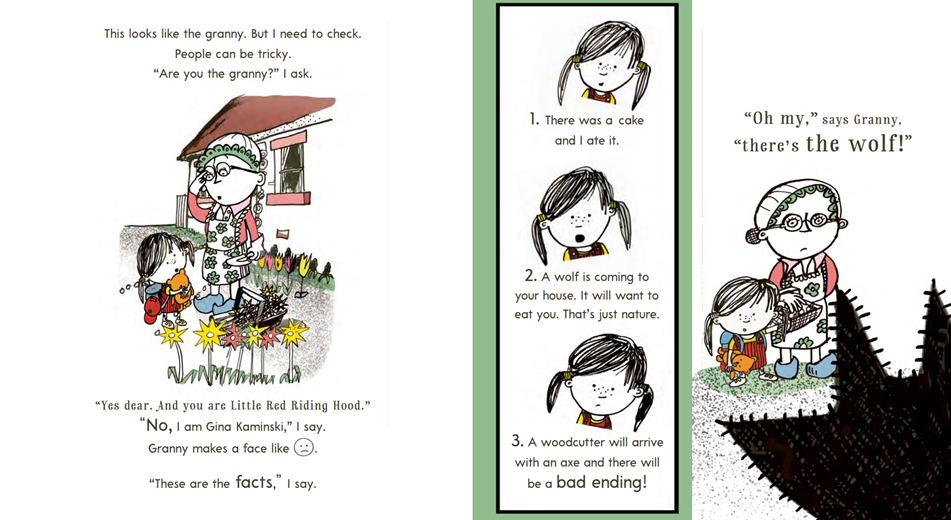
3. Can you talk us through the illustration style you have used to help tell Gina's story? What were the challenges?
Gina Kaminski Saves the Wolf has two worlds, the chaotic and difficult to manage classroom and the slightly stylised fairy tale world. I had to play around with lots of ideas and eventually developed a look for both worlds. The school was based on real schools, my own memories and quite a bit of observation from running workshops. Sometimes they do get a bit too lively. Teachers would also alert me to children with autism who found the workshops too much.
The fairy tale was referenced from books and films. It was more artificial, and apart from the Wolf, who was based on my favourite dogs, the fairy tale characters were a deliberately a bit cartoonish. The Woodcutter was based on a statue in the village of Hale called The Childe of Hale. It's a 9 ft tall giant who won a wrestling match with King James 1's champion, and was given £20.00. Unfortunately, on his way back to Merseyside, he was mugged in Stevenage (true story).
Once I had developed the two worlds, I had to created bridges and links between them. Having Gina talk to the reader occasionally was one of the techniques to do this. Initially there were some very overt transitions, Gina actually stepping into the book, climbing through a bookshelf, but in the end I trusted the reader to follow Gina and accept that she is just amazing.
4. How does the layout and colour palette support this?
The colour palette and the look were very deliberate. It was important that the book wouldn't be hyper stimulating. Rebecca (art director) and I looked at the palettes used in picture books from the 50's and 60's when there was limited access to full colour. We liked the effect and thought it enhanced the narrative. An important part of the story is Gina's response to being in over-stimulating environments. We decided that this book wouldn't overload the senses and avoided gimmicks. It also let Gina's facial expressions be the focus.
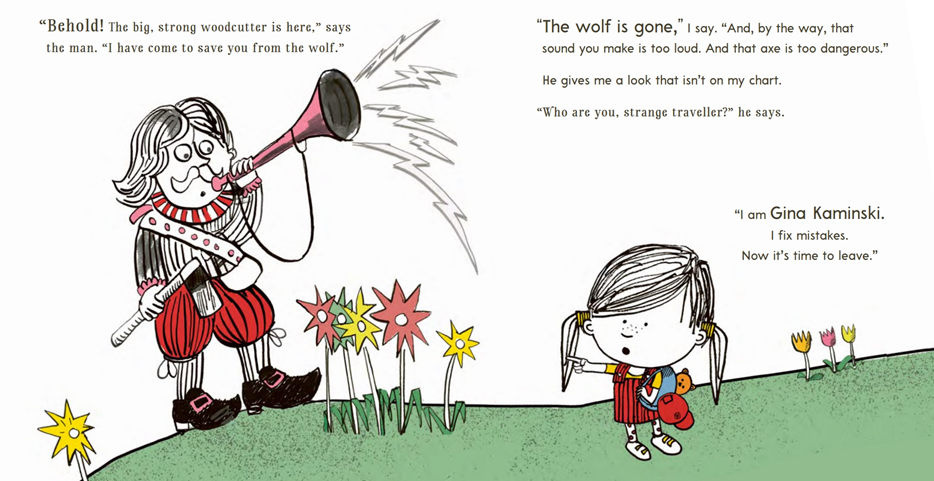
5. Gina uses emojis to help tell her story - why did you decide to also create the end papers using them?
I would like to say that that was my brilliant idea; alas it was not. Rebecca the art director saw the potential of using the emojis as an end page.
6. What other stories are you working on currently? Where do you do your illustration work?
I'm working on the next Gina story at the moment, which is brilliant!! Craig has created another Fairy tale fix-it. Doing a follow up book is fantastic and as Gina is established she genuinely feels like an autonomous personality. I (maybe Craig as well) have to try figure out:
- how she looks,
- what she says
- what she does.
Because she will pull us up if we do the wrong thing.
I also like writing and drawing my own stories. Serious stories about Dad's trousers running away, a boy who's snot turns into a snail and grants him three wishes, a girl who thinks she's invisible but isn't, another girl who brings a crocodile home from the zoo as there is nothing in the gift shop she fancies……. (That's enough touting for business).
7. What are your favourite ways of spending time away from your desk?
Things I like doing when not at my drawing desk:
- I am quite fond of hanging out with dogs and as long as there's a walk or treats involved they seem up for it.
- Drawing outdoors is fun.
- Sitting in trains watching the world go by.
- Going to old museums and art galleries. The Walker in Liverpool is my current fav!
- Not talking about football.

 Gina Kaminski Saves the Wolf
Gina Kaminski Saves the Wolf
